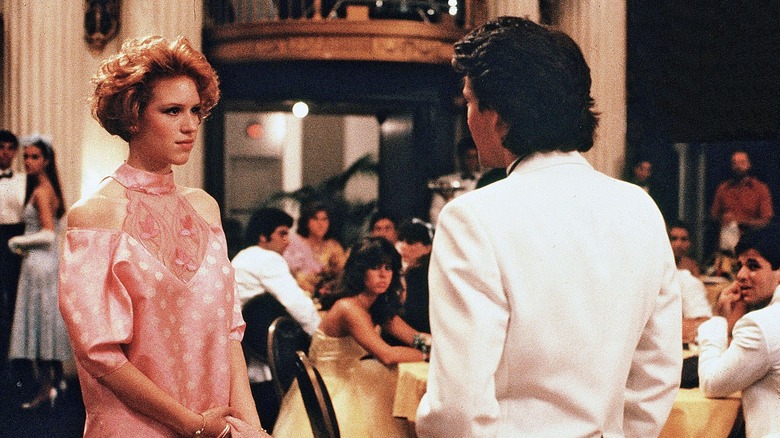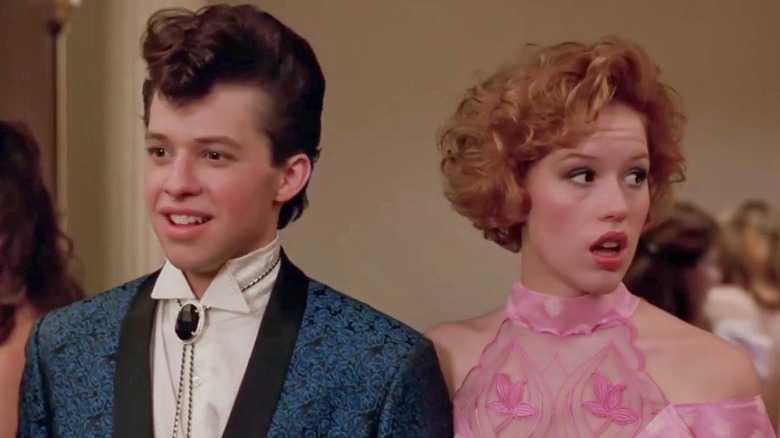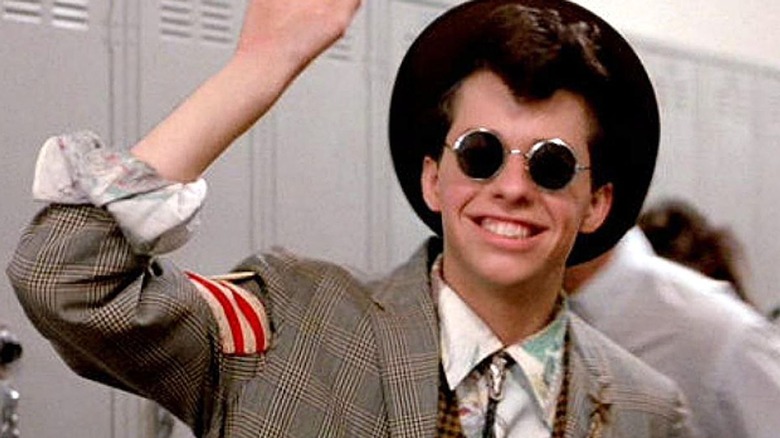The Original Pretty In Pink Ending Test Audiences Couldn't Stand
35 years ago, John Hughes released "Pretty in Pink," arguably the "Return of the Jedi" of his trilogy of teen films starring Molly Ringwald. The story centers on a hip and stylish teenager named Andie, a girl from a lower-class family attending a wealthy private school in Chicago. Andie works at the record store, does everything with her best friend, the equally lower-class Duckie (Jon Cryer), and navigates a world filled with teenage hormones surrounded by wealthy classmates who might as well be from a different planet. Things change for Andie when the rich and dreamy Blane (Andrew McCarthy) asks her out, thrusting them both into a fish-out-of-water situation of trying to understand one another, while heartbroken Duckie realizes that Andie only sees him as a friend.
Toward the end of the movie, Andie pushes Blane away, calling him out for avoiding her and not returning her calls, knowing full well it's because his rich friends do not approve of his relationship with her. Andie then goes to the prom in a dress she made herself, reunites with heartbroken Duckie, and then later, reconciles with Blane, admitting the two are in love. It's a Hughes era classic, but the film's original ending had a much different ending ... one that audiences absolutely hated.
No Love for The Duckman
In the film's original ending, Andie's reunion at the prom with Duckie was also a romantic one. According to director Howard Deutch from an interview with USA Today, "Up to that point, the screening had been like a rock concert. And we got to the ending, and they started to boo," says Deutch, who insists there were actual boos. "That young audience, they did not want Molly to end up with Jon Cryer. The girls were like, 'Forget the politics. We want her to get the cute boy."
Test audiences hated the idea of Andie ending up with Duckie so much, Hughes quickly wrote a new five-page ending having Andie wind up with Blane. The ending betrays the underdog setup of Andie and Duckie making it out of their privileged high school together, and the crew was only given one day to re-shoot the entire ending. Andrew McCarthy had already changed his appearance for a Broadway play and was forced to wear a wig for the final moments, Duckie was given a new love interest in the form of Kristy Swanson, and Blane's redemption needed to look sympathetic. 1986 audiences loved the new ending, but in the years since, many have argued that the new ending has aged poorly, and that the film would have been better suited with Andie and Duckie ending up together.
In reality, the new ending is the correct one. Let me explain.
Duckie Not-So Secretly Sucks
Jon Cryer's "Duckie" is a beloved character, frequently cited as one of the underdog heroes of cinema and the president of the dreaded "friend zone." Here's the thing, though: Duckie secretly sucks. As a best friend, he never communicates his true feelings to Andie and just expects her to pick up on his subtext. He immediately judges her with harsh intensity for daring to have feelings for someone other than him, tries to win her over with giant, unsolicited gestures, and throws a public tantrum when things don't turn out his way. Duckie is the de facto "nice guy" who feels entitled to the object of his affection's attention just because he's not a total piece of garbage.
That said, Duckie is also frequently read as a closeted queer character, and if that's the case, his anger and outbursts would be rooted in fear, and his actions feel a lot more justifiable. However, if Duckie is straight, his actions are a step above a whiny incel. To be perfectly honest, the best ending would have been if Andie told all of the men in her life to kick rocks, gone off to art school, and lived her best college life. That way, Andie could truly let them all know that they couldn't break her.


